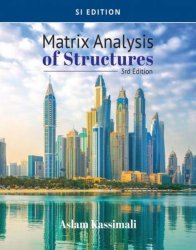 Название: Matrix Analysis of Structures, SI Edition, 3rd Edition
Название: Matrix Analysis of Structures, SI Edition, 3rd EditionАвтор: Aslam Kassimali
Издательство: Cengage Learning
Год: 2022
Страниц: 658
Язык: английский
Формат: pdf (true)
Размер: 34.7 MB
Develop an understanding of the matrix method of structural analysis with the contemporary, reader-friendly approach found in Kassimali's MATRIX ANALYSIS OF STRUCTURES, SI, 3rd Edition. Whether you are an advanced undergraduate or graduate student, this edition serves as an excellent resource for understanding all key aspects of the matrix method of structural analysis. Unlike traditional books that are difficult to read, this edition provides understandable, clear explanations of concepts with updated photographs and diagrams as well as flowcharts. Step-by-step procedures guide you through analysis while updated, intriguing examples clarify concepts. New and current exercises include problems working with practical, real-world structures to give you meaningful practice. Trust this technically and mathematically accurate presentation to provide the foundation you need in matrix structural analysis.
The objective of this book is to develop an understanding of the basic principles of the matrix methods of structural analysis, so that they can be efficiently implemented on modern computers. Focusing on the stiffness approach, Matrix Analysis of Structures, SI Version covers the linear analysis of two- and three- dimensional framed structures in static equilibrium. It also presents an introduction to nonlinear structural analysis and contains the fundamentals of the flexibility approach.
The book is divided into ten chapters. Chapter 1 presents a general introduction to the subject, and Chapter 2 reviews the basic concepts of matrix algebra relevant to matrix structural analysis. The next five chapters (Chapters 3 through 7) cover the analysis of plane trusses, beams, and plane rigid frames. The computer implementation of the stiffness method is initiated early in the text (beginning with Chapter 4), to allow students sufficient time to complete development of computer programs within the duration of a single course. Chapter 8 presents the analysis of space trusses, grids, and space rigid frames, Chapter 9 covers some special topics and modeling techniques, and Chapter 10 provides an introduction to nonlinear structural analysis. All the relationships necessary for matrix stiffness analysis are formulated using the basic principles of the mechanics of deformable bodies. Thus, a prior knowledge of the classical methods of structural analysis, while helpful, is not essential for understanding the material presented in the book. The format of the book is flexible enough to enable instructors to emphasize topics that are consistent with the goals of the course.
Each chapter begins with a brief introduction that defines its objectives, and ends with a summary outlining its salient features. An important general feature of the book is the inclusion of step-by-step procedures for analysis, and detailed flowcharts, to enable students to make an easier transition from theory to problem solving and program development. Numerous solved examples are provided to clarify the fundamental concepts, and to illustrate the application of the procedures for analysis.
A computer program for the analysis of two- and three-dimensional framed structures is available on the publisher’s website. This interactive software can be used by students to check their answers to text exercises, and to verify the correctness of their own computer programs.
Скачать Matrix Analysis of Structures, SI Edition, 3rd Edition